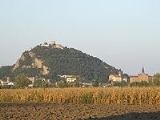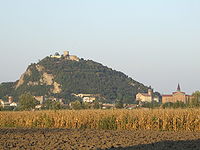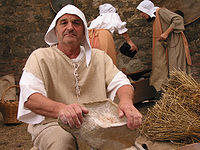
Monselice
Encyclopedia
Monselice is a town and municipality (comune
) located in northeastern Italy
, in the Veneto
region, in the province of Padua
.
It is about 20 km southeast of the city of Padua
, at the southern edge of the Euganean Hills
(Colli Euganei
).
hero Opsicella. The area shows evidence of human settlement since the Bronze Age
.
In Roman times it was known as Mons Silicis, meaning "mountain of flint
stone", possibly due to the local quarries of trachyte
.
The earliest known documents about Monselice date back to 568 CE and are related to the conquest of the town by the Lombards
. The town was under Byzantine
rule for a brief period until its conquest by king Agilulf
around 602.
During the Comuni
period (12th century) the town had its own local self-government. The town was aligned with the Ghibellines against the Guelphs in the political and military fights of the 13th century.
The Ghibelline leader Ezzelino III da Romano
improved the town's fortifications and made it one of the main strongholds of the area.
The town was then under the Carraresi (the lords of Padua) rule and in the 15th century it became part of the Republic of Venice
.
After a short period of French domination, it was part of the Austrian Empire
and, later, of its client Kingdom of Lombardy-Venetia.
In 1866 it became part of the Kingdom of Italy.

 The modern town lies in a wide valley between the Montericco (312 m) and the Rocca (110 m) hills (part of the Euganean Hills).
The modern town lies in a wide valley between the Montericco (312 m) and the Rocca (110 m) hills (part of the Euganean Hills).
The oldest part of the town lies around the Rocca hill.
In medieval times the Rocca was heavily fortified with five girdle walls that are partially still visible today.
Important points for tourists can be the central square Piazza Mazzini with the medieval Torre Civica (Civic Tower) and the Palazzo del Monte di Pietà(Public Pawn Palace). This building hosts the local touristic promotion board (Pro Loco), that provides information for visits to the town's historical attractions.
Piazza Mazzini square is also the starting point for the promenade walk along Via del Santuario, leading to the most interesting sites of the town, which include:
Monselice is an ideal starting point for excursions to the http://www.parcocollieuganei.comEuganean Hills
] (Colli Euganei).
An important fair is traditionally held every year around November 1 (All Saints Day - saint patron day for the town). Attractions include a food and general market, local food stands, fun park, exhibits.
Started in recent years, the "Palio di Monselice" tournament has become a primary attraction. The Palio is held every year in September. It is modeled after medieval horse tournaments and it includes a medieval parade.
, Venice
and Bologna
.
Monselice railway station is on the Venice-Padua-Bologna-Florence line, between Padua (North) and Bologna (South). A secondary railway line connects Monselice to the town of Mantua
(Mantova), in Lombardy.
The nearest airports are Venice (VCE) (60 km) and Bologna (BLQ) (100 km).
Comune
In Italy, the comune is the basic administrative division, and may be properly approximated in casual speech by the English word township or municipality.-Importance and function:...
) located in northeastern Italy
Italy
Italy , officially the Italian Republic languages]] under the European Charter for Regional or Minority Languages. In each of these, Italy's official name is as follows:;;;;;;;;), is a unitary parliamentary republic in South-Central Europe. To the north it borders France, Switzerland, Austria and...
, in the Veneto
Veneto
Veneto is one of the 20 regions of Italy. Its population is about 5 million, ranking 5th in Italy.Veneto had been for more than a millennium an independent state, the Republic of Venice, until it was eventually annexed by Italy in 1866 after brief Austrian and French rule...
region, in the province of Padua
Province of Padua
The Province of Padua is a province in the Veneto region of Italy. Its capital is the city of Padua.-History and territory:...
.
It is about 20 km southeast of the city of Padua
Padua
Padua is a city and comune in the Veneto, northern Italy. It is the capital of the province of Padua and the economic and communications hub of the area. Padua's population is 212,500 . The city is sometimes included, with Venice and Treviso, in the Padua-Treviso-Venice Metropolitan Area, having...
, at the southern edge of the Euganean Hills
Euganean Hills
The Euganean Hills are a group of hills of volcanic origin that rise to heights of 300 to 600 meters from the Padovan-Venetian plain a few kilometers south of Padua. The Colli Euganei form the first regional park established in the Veneto, enclosing fifteen towns and eighty-one hills...
(Colli Euganei
Colli Euganei
Colli Euganei are located in the Veneto region of northern Italy, a few kilometers south of Padua. They take their name from the Euganei, a semi-mythical population who inhabited the area before the Veneti....
).
History
The town's mythological foundation is attributed to the TrojanTroy
Troy was a city, both factual and legendary, located in northwest Anatolia in what is now Turkey, southeast of the Dardanelles and beside Mount Ida...
hero Opsicella. The area shows evidence of human settlement since the Bronze Age
Bronze Age
The Bronze Age is a period characterized by the use of copper and its alloy bronze as the chief hard materials in the manufacture of some implements and weapons. Chronologically, it stands between the Stone Age and Iron Age...
.
In Roman times it was known as Mons Silicis, meaning "mountain of flint
Flint
Flint is a hard, sedimentary cryptocrystalline form of the mineral quartz, categorized as a variety of chert. It occurs chiefly as nodules and masses in sedimentary rocks, such as chalks and limestones. Inside the nodule, flint is usually dark grey, black, green, white, or brown in colour, and...
stone", possibly due to the local quarries of trachyte
Trachyte
Trachyte is an igneous volcanic rock with an aphanitic to porphyritic texture. The mineral assemblage consists of essential alkali feldspar; relatively minor plagioclase and quartz or a feldspathoid such as nepheline may also be present....
.
The earliest known documents about Monselice date back to 568 CE and are related to the conquest of the town by the Lombards
Lombards
The Lombards , also referred to as Longobards, were a Germanic tribe of Scandinavian origin, who from 568 to 774 ruled a Kingdom in Italy...
. The town was under Byzantine
Byzantine Empire
The Byzantine Empire was the Eastern Roman Empire during the periods of Late Antiquity and the Middle Ages, centred on the capital of Constantinople. Known simply as the Roman Empire or Romania to its inhabitants and neighbours, the Empire was the direct continuation of the Ancient Roman State...
rule for a brief period until its conquest by king Agilulf
Agilulf
Agilulf called the Thuringian, was a duke of Turin and king of the Lombards from 591 until his death.-Biography:A relative of his predecessor Authari, he was selected king on the advice of the Christian queen and widow of Authari, Theodelinda, whom he then married...
around 602.
During the Comuni
Medieval commune
Medieval communes in the European Middle Ages had sworn allegiances of mutual defense among the citizens of a town or city. They took many forms, and varied widely in organization and makeup. Communes are first recorded in the late 11th and early 12th centuries, thereafter becoming a widespread...
period (12th century) the town had its own local self-government. The town was aligned with the Ghibellines against the Guelphs in the political and military fights of the 13th century.
The Ghibelline leader Ezzelino III da Romano
Ezzelino III da Romano
Ezzelino III da Romano was an Italian feudal lord in the March of Treviso who was a close ally of the emperor Frederick II and ruled Verona, Vicenza and Padua for almost two decades...
improved the town's fortifications and made it one of the main strongholds of the area.
The town was then under the Carraresi (the lords of Padua) rule and in the 15th century it became part of the Republic of Venice
Republic of Venice
The Republic of Venice or Venetian Republic was a state originating from the city of Venice in Northeastern Italy. It existed for over a millennium, from the late 7th century until 1797. It was formally known as the Most Serene Republic of Venice and is often referred to as La Serenissima, in...
.
After a short period of French domination, it was part of the Austrian Empire
Austrian Empire
The Austrian Empire was a modern era successor empire, which was centered on what is today's Austria and which officially lasted from 1804 to 1867. It was followed by the Empire of Austria-Hungary, whose proclamation was a diplomatic move that elevated Hungary's status within the Austrian Empire...
and, later, of its client Kingdom of Lombardy-Venetia.
In 1866 it became part of the Kingdom of Italy.
Main sights


The oldest part of the town lies around the Rocca hill.
In medieval times the Rocca was heavily fortified with five girdle walls that are partially still visible today.
Important points for tourists can be the central square Piazza Mazzini with the medieval Torre Civica (Civic Tower) and the Palazzo del Monte di Pietà(Public Pawn Palace). This building hosts the local touristic promotion board (Pro Loco), that provides information for visits to the town's historical attractions.
Piazza Mazzini square is also the starting point for the promenade walk along Via del Santuario, leading to the most interesting sites of the town, which include:
- The Castle of Monselice (or Castello Cini), which houses one of the most important collections of European medieval weapons and armors.
- Villa Nani.
- The Romanesque church of Santa Giustina (12th century).
- The Seven Churches Sanctuary (Santuario delle Sette Chiese or Via Romana) with paintings by Palma il Giovane. Pietro Duodo (1554-1610), a Venetian patrician, committed to architect Vincenzo ScamozziVincenzo Scamozzithumb|250px|Portrait of Vincenzo Scamozzi by [[Paolo Veronese]]Vincenzo Scamozzi was a Venetian architect and a writer on architecture, active mainly in Vicenza and Republic of Venice area in the second half of the 16th century...
the project for the Santuario delle Sette Chiese. In 1606, Pope Paul VPope Paul V-Theology:Paul met with Galileo Galilei in 1616 after Cardinal Bellarmine had, on his orders, warned Galileo not to hold or defend the heliocentric ideas of Copernicus. Whether there was also an order not to teach those ideas in any way has been a matter for controversy...
issued a papal bull that granted to pilgrims visiting the Sanctuary the same Catholic indulgencies granted to pilgrims visiting the seven main churches (basiliche) of Rome, hence the "Romanis Basilicis Pares" inscription on the portal of the sanctuary. - Villa DuodoVilla DuodoVilla Duodo also known as the is a villa situated at Monselice near Padua in the Veneto, northern Italy. It is attributed to the architect Vincenzo Scamozzi although some later parts are known to have been designed by Andrea Tirali. The villa was built for a Venetian patrician, Francesco Duodo,...
, designed by ScamozziVincenzo Scamozzithumb|250px|Portrait of Vincenzo Scamozzi by [[Paolo Veronese]]Vincenzo Scamozzi was a Venetian architect and a writer on architecture, active mainly in Vicenza and Republic of Venice area in the second half of the 16th century...
. - The Keep (Mastio or Torrione), still standing on the Rocca hilltop. It is a massive tower built with huge regular trachyte blocks from local quarries.
Monselice is an ideal starting point for excursions to the http://www.parcocollieuganei.comEuganean Hills
Euganean Hills
The Euganean Hills are a group of hills of volcanic origin that rise to heights of 300 to 600 meters from the Padovan-Venetian plain a few kilometers south of Padua. The Colli Euganei form the first regional park established in the Veneto, enclosing fifteen towns and eighty-one hills...
] (Colli Euganei).
Culture
A lively market is held every Monday in the town's main streets.An important fair is traditionally held every year around November 1 (All Saints Day - saint patron day for the town). Attractions include a food and general market, local food stands, fun park, exhibits.
Started in recent years, the "Palio di Monselice" tournament has become a primary attraction. The Palio is held every year in September. It is modeled after medieval horse tournaments and it includes a medieval parade.
Transportation
Monselice is well connected to the major towns of PaduaPadua
Padua is a city and comune in the Veneto, northern Italy. It is the capital of the province of Padua and the economic and communications hub of the area. Padua's population is 212,500 . The city is sometimes included, with Venice and Treviso, in the Padua-Treviso-Venice Metropolitan Area, having...
, Venice
Venice
Venice is a city in northern Italy which is renowned for the beauty of its setting, its architecture and its artworks. It is the capital of the Veneto region...
and Bologna
Bologna
Bologna is the capital city of Emilia-Romagna, in the Po Valley of Northern Italy. The city lies between the Po River and the Apennine Mountains, more specifically, between the Reno River and the Savena River. Bologna is a lively and cosmopolitan Italian college city, with spectacular history,...
.
Monselice railway station is on the Venice-Padua-Bologna-Florence line, between Padua (North) and Bologna (South). A secondary railway line connects Monselice to the town of Mantua
Mantua
Mantua is a city and comune in Lombardy, Italy and capital of the province of the same name. Mantua's historic power and influence under the Gonzaga family, made it one of the main artistic, cultural and notably musical hubs of Northern Italy and the country as a whole...
(Mantova), in Lombardy.
The nearest airports are Venice (VCE) (60 km) and Bologna (BLQ) (100 km).
External links
- Town map
- Monselice Turismo (Monselice touristic portal)
- The Castle of Monselice (Ca' Marcello)
- Touristic Promotion Board (Pro Loco, in Italian)
- A selection of Monselice postcards
- Ralph Waldo Emerson's impressions of Monselice

